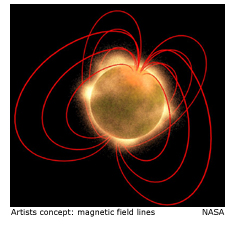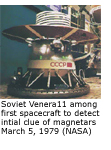|
|
 Prediction and Confirmation of 'Magnetars' Wins UT
Scientist and Colleagues Rossi Prize
Prediction and Confirmation of 'Magnetars' Wins UT
Scientist and Colleagues Rossi Prize
17 February 2003
Austin, TX --The 2003 Rossi Prize of the High Energy Astrophysics Division of the American Astronomical
Society is awarded to Robert Duncan and Christopher Thompson for their prediction, and to Chryssa
Kouveliotou for her observational confirmation, of the existence of magnetars: neutron stars with
extraordinarily strong magnetic fields. The prize is awarded annually for a significant contribution to
High Energy Astrophysics, with particular emphasis on recent, original work.
 The work explains the mystery associated with soft gamma repeaters (SGR's), neutron stars that emit regular,
powerful bursts in the gamma ray spectrum, and anomalous x-ray pulsars (AXP's), neutron stars with slow rotation periods,
which suggest they are old, yet are associated with young supernova remnants.
The work explains the mystery associated with soft gamma repeaters (SGR's), neutron stars that emit regular,
powerful bursts in the gamma ray spectrum, and anomalous x-ray pulsars (AXP's), neutron stars with slow rotation periods,
which suggest they are old, yet are associated with young supernova remnants.
Neutron stars are created when normal but massive stars expend their fuel and collapse in supernova. One analogy
compares the process to compressing a battleship into the head of a pin. A common type of neutron star is a radio pulsar,
which emits beams of radio waves, like a lighthouse, as it spins at phenomenal speed.
Robert Duncan of the University of Texas at Austin and Christopher Thompson of the Canadian Institute
for Theoretical Astrophysics in Toronto were attempting to explain the origin of magnetic
fields in radio pulsars when they first developed the theory of magnetars in 1992.
They suggested, to widespread skepticism, that neutron stars could develop extraordinary magnetic fields under
certain conditions—rapid enough spin, and convection, the internal roiling movement of hot, atomic liquid inside a pulsar
(1014 times more dense than liquid water on earth). This convection dynamo is the same process thought to
generate earth's weak magnetic field.
If confirmed, the magnetic fields Duncan and Thompson calculated would be the
strongest generated by known objects in the universe, and perhaps 1,000 times stronger than the fields in most
radio pulsars. (Attempting such fields experimentally on earth would blow apart the electromagnet!)
Such strong magnetic fields would cause neutron stars to behave in specific ways. The predicted behavior of magnetars ultimately
led to confirmation of the
model, by way of explaining some other mysterious events occurring in the sky.
The Burst of March 5, 1979
In March of 1979, ten spacecraft in our solar system registered a burst of gamma radiation 100 times more powerful
than any previously detected, as much energy as the sun releases in roughly 10,000 years. It lasted two
tenths of a second, and was followed by a glow of gamma rays and x-rays, fading and pulsing at 8 second intervals
for another three minutes. 14 ½ hours later another fainter burst occured. And over the next 4 years, 16 bursts,
all coming from the same place.
Astronomers had seen nothing like this. Unlike the more familiar gamma ray bursts, it repeated. (Subsequent detections
were eventually dubbed soft gamma repeaters, or SGR's).
Triangulating from the position of the spacecraft, astronomers pinpointed the origin of the March burst, a supernova
remnant in the Large Magellanic Cloud, a neighboring galaxy.
 Supernova remnants are often associated with radio pulsars. But the apparant rotation of this object was too slow,
at 8 seconds, and it was emitting waves more energetic than radio, in the x-ray and gamma range.
Supernova remnants are often associated with radio pulsars. But the apparant rotation of this object was too slow,
at 8 seconds, and it was emitting waves more energetic than radio, in the x-ray and gamma range.
As the theoretical magnetar model developed, it accounted for the apparant spin rate of the 1979 SGR. Neutron stars
are known to spin down. A stronger magnetic field would slow the spin considerably faster.
The model would also account for the energy. A feature unique
to neutron stars is that they have a crust. Ultra strong magnetic fields generated
within a magnetar could cause the crust to bend and shift, a starquake, and occasionally break, creating a cloud of
electrons and positrons and soft gamma rays, of the kind and strength observed as SGR's.
Chryssa Kouveliotou of the Universities Space Research Association with the help of observations made at the
Institute of Space and Astronautical Science in Japan confirmed the spin down rate of SGR 1806-20 to be nearly
2 parts in 1,000 over five years, suggesting a rate higher than any known radio pulsar and indicative
of a magnetic field in agreement with the magnetar model of 1015 gauss.
more news..
|
|

 Prediction and Confirmation of 'Magnetars' Wins UT
Scientist and Colleagues Rossi Prize
Prediction and Confirmation of 'Magnetars' Wins UT
Scientist and Colleagues Rossi Prize The work explains the mystery associated with soft gamma repeaters (SGR's), neutron stars that emit regular,
powerful bursts in the gamma ray spectrum, and anomalous x-ray pulsars (AXP's), neutron stars with slow rotation periods,
which suggest they are old, yet are associated with young supernova remnants.
The work explains the mystery associated with soft gamma repeaters (SGR's), neutron stars that emit regular,
powerful bursts in the gamma ray spectrum, and anomalous x-ray pulsars (AXP's), neutron stars with slow rotation periods,
which suggest they are old, yet are associated with young supernova remnants.
 Supernova remnants are often associated with radio pulsars. But the apparant rotation of this object was too slow,
at 8 seconds, and it was emitting waves more energetic than radio, in the x-ray and gamma range.
Supernova remnants are often associated with radio pulsars. But the apparant rotation of this object was too slow,
at 8 seconds, and it was emitting waves more energetic than radio, in the x-ray and gamma range.